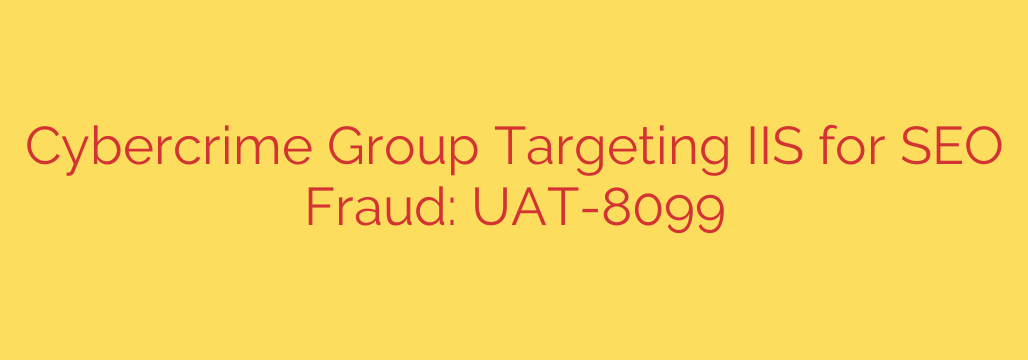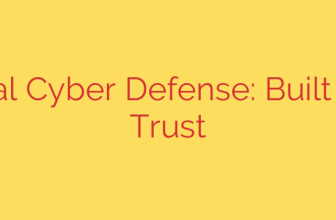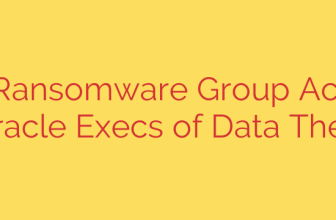
Warning: Hackers Are Hijacking IIS Servers for Advanced SEO Poisoning Attacks
Your website’s search engine ranking is one of its most valuable assets. It drives organic traffic, builds authority, and connects you with your audience. However, a sophisticated threat is actively targeting Microsoft Internet Information Services (IIS) web servers with the express purpose of destroying your SEO and redirecting your hard-earned traffic to malicious sites.
This attack, known as SEO poisoning, is a stealthy and destructive form of cybercrime. By compromising your server, attackers can manipulate what search engines see, effectively hijacking your search results for their own criminal enterprises. Understanding how this attack works is the first step toward protecting your digital presence.
How the IIS SEO Poisoning Attack Works
Unlike simple website hacks that deface a homepage, this attack is far more subtle. The primary goal is to remain undetected for as long as possible while exploiting your website’s authority.
Here’s the typical chain of events:
- Initial Compromise: Attackers gain initial access to an IIS server, often by exploiting unpatched vulnerabilities in web applications, content management systems, or through weak administrative credentials.
- Installation of a Malicious Module: Once inside, they install a malicious IIS module. This module is often disguised with a legitimate-sounding name like
Rewrite.dllto blend in with normal server components and avoid detection by administrators. - Content Injection and Cloaking: The malicious module intercepts traffic to your website. It then uses a technique called “cloaking” to show different content to search engine crawlers (like Googlebot) than it does to actual human visitors.
- For Search Engines: The module injects spammy keywords, links, and even entire pages of unrelated content. This content is designed to rank for illegitimate search terms, such as those for counterfeit goods, illegal services, or scam websites.
- For Human Visitors: Your website may appear perfectly normal to you and your users, making the hack incredibly difficult to spot.
The ultimate goal is to use your website’s good reputation to boost the search ranking of malicious pages. Once those pages rank highly, the attackers can redirect unsuspecting searchers to scam sites, phishing pages, or malware downloads. This not only puts visitors at risk but can also cause search engines to penalize or completely de-index your website, destroying your organic traffic.
Is Your Website at Risk? Signs of an Infection
Because this attack is designed to be invisible to the site owner, detection can be tricky. However, there are several red flags you should watch for:
- A sudden, unexplained drop in organic traffic or a sharp decline in keyword rankings.
- Receiving warnings from Google Search Console about spam, cloaking, or unexpected redirects.
- Searching for your own site and finding strange, irrelevant results or page titles in the search listings.
- Discovering unfamiliar files or modules in your IIS server’s directories, particularly within
C:\Windows\System32\inetsrv\. - Customer complaints about being redirected to another website after clicking a search result for your page.
If you notice any of these symptoms, you should investigate immediately.
How to Protect Your IIS Server and Secure Your SEO
Proactive security is the only effective defense against this type of attack. Waiting until your rankings have plummeted is too late. Here are critical, actionable steps every IIS administrator and website owner should take.
1. Prioritize Patch Management
The vast majority of compromises begin with an unpatched vulnerability. Regularly update your Windows Server OS, the IIS framework itself, and all web applications (e.g., WordPress, Joomla, .NET applications) running on the server. Automate patching where possible.
2. Enforce Strong Credential Security
Weak passwords are an open invitation for attackers. Implement a strict password policy for all accounts with access to the server. Most importantly, enable Multi-Factor Authentication (MFA) for all remote access points, including Remote Desktop Protocol (RDP) and administrative panels.
3. Regularly Audit Your IIS Modules
Make it a routine to inspect the installed IIS modules on your server. Be suspicious of any DLL files in the IIS directory that you don’t recognize. Compare your module list to a known-good configuration or a clean installation to spot unauthorized additions.
4. Monitor Server Logs and Network Traffic
Keep a close eye on your server’s logs for unusual activity, such as strange GET requests, unexpected user-agent strings, or connections to suspicious IP addresses. Monitoring outbound traffic can also help detect if a malicious module is communicating with a command-and-control server.
5. Use Google Search Console Actively
This free tool is one of your best allies. Regularly check the “Security Issues” report and use the “URL Inspection” tool. The “View crawled page” feature can sometimes reveal the cloaked content that is being shown to Googlebot, allowing you to see what the attackers are doing.
By taking these threats seriously and implementing a robust, multi-layered security strategy, you can protect your server, preserve your SEO rankings, and ensure your website remains a safe and trusted resource for your audience.
Source: https://blog.talosintelligence.com/uat-8099-chinese-speaking-cybercrime-group-seo-fraud/








